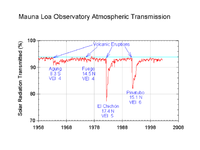
Photo from wikipedia
Abstract This paper presents a framework for assessing the physical consistency between time-series of several satellite-based surface albedo and burned area products at global scale. The methodology evaluates the level… Click to show full abstract
Abstract This paper presents a framework for assessing the physical consistency between time-series of several satellite-based surface albedo and burned area products at global scale. The methodology evaluates the level of agreement of temporal change between these two Essential Climate Variables (ECVs) taking into account their uncertainties. Several configurations of surface albedo and burned area products, including the ones from MODIS Collection 6, Copernicus Global Land Service (C-GLS), Climate Change Initiative (CCI) and the GlobAlbedo, were analysed over the 2005–2011 period at 0.05°× 0.05° spatial resolution. The study evaluates the temporal and spatial coherence level in the ECV changes, and explores the product dependency impact on the fire-driven radiative forcings. The main findings indicate that the level of agreement between these two ECVs depends on the product combination but also on the albedo broadband. Whereas both GlobAlbedo and MODIS albedo changes are consistent both temporally and spatially when combined with any burned area product, the C-GLS albedo changes are characterised by lower levels of agreement. The results also indicate that surface albedo and burned area product changes are physically coherent for all biomes except grasslands and croplands, when using the MODIS burned area product. Using different combinations of burned area and surface albedo products, fire-induced radiative forcing estimates at the surface can differ, according to the biome, by 26% to 46%. The proposed framework identifies lack of coherency and consistency between the two ECVs. This novel approach allows us to address cross-ECV compatibility, and as such offers a valuable toolset to users.
Journal Title: Remote Sensing of Environment
Year Published: 2019
Link to full text (if available)
Share on Social Media: Sign Up to like & get
recommendations!